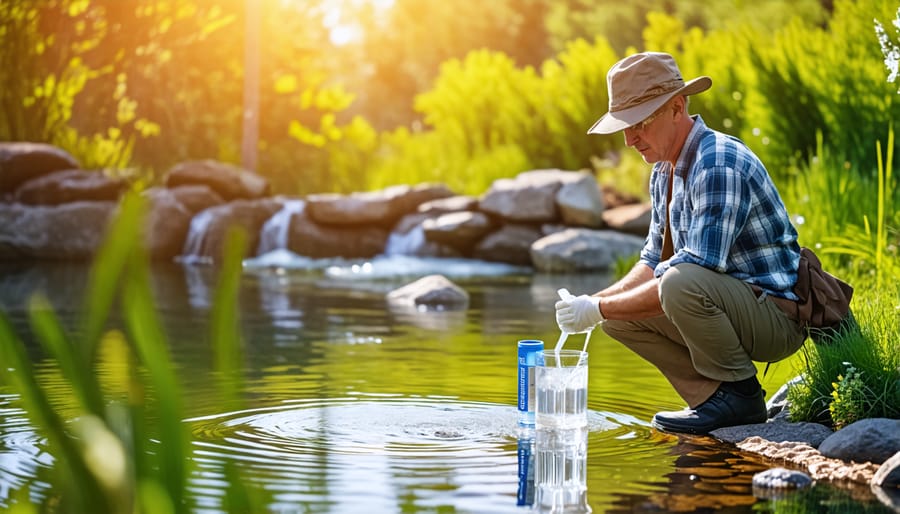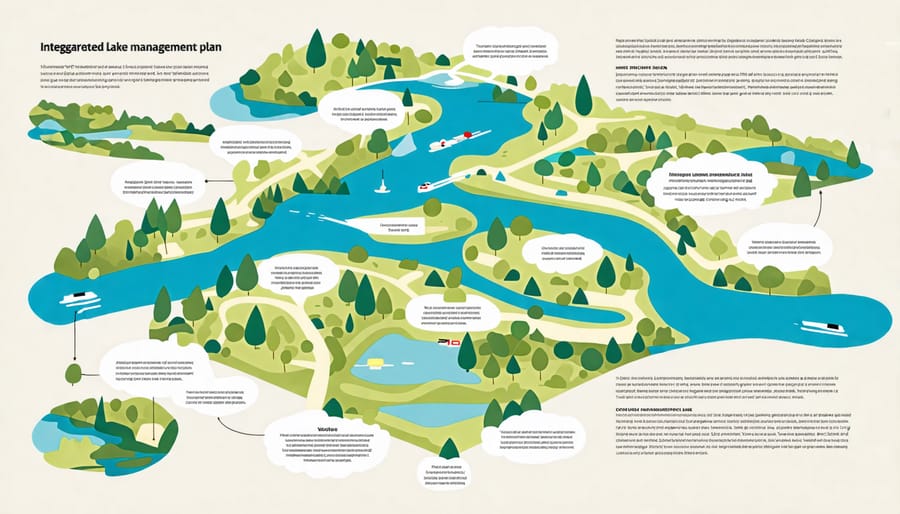
Integrated Lake Management: The Key to a Healthy, Thriving Water Garden
Establish a comprehensive understanding of your lake’s unique ecosystem by evaluating water quality, nutrient levels, and biodiversity. Test key parameters regularly and monitor changes over time.
Develop an integrated management plan that addresses your lake’s specific challenges. Incorporate strategies for controlling aquatic weeds, reducing nutrient runoff, enhancing fisheries, and promoting native vegetation.
Implement your plan consistently, making adjustments as needed based on ongoing monitoring results. Engage stakeholders, educate the community, and seek professional guidance when necessary to ensure long-term success.
By taking a proactive, holistic approach to lake management, you can maintain a healthy, resilient ecosystem that supports diverse wildlife, recreational activities, and aesthetic beauty for generations to come.
Understanding Your Lake Ecosystem

Water Chemistry
Water chemistry plays a vital role in maintaining a healthy and thriving lake ecosystem. The pH level of your lake water is a crucial factor to monitor, as it affects the availability of nutrients and the well-being of aquatic life. Optimal pH levels for most lakes range between 6.5 and 8.5. Nutrients such as nitrogen and phosphorus are essential for plant growth, but excessive amounts can lead to algal blooms and water quality issues. Regular water chemistry testing and balancing can help you maintain the delicate equilibrium within your lake. Other important chemical parameters to keep an eye on include dissolved oxygen, which is necessary for fish and other aquatic organisms to thrive, and alkalinity, which helps buffer against sudden changes in pH. By understanding and managing these key chemical factors, you can create a harmonious and sustainable lake environment.
Aquatic Plants
Aquatic plants play a vital role in maintaining the delicate balance of your water garden ecosystem. These beneficial plants not only add beauty and texture to your pond but also help keep the water clean and clear. Aquatic plants absorb excess nutrients, preventing algae growth and providing shelter for fish and other aquatic life. They also oxygenate the water, creating a healthier environment for all inhabitants. When selecting plants for your pond, consider a mix of submerged, marginal, and floating varieties to create a diverse and thriving ecosystem. Aim for a balance of 50-70% plant coverage on your pond’s surface to maintain optimal water quality and clarity. Remember to monitor plant growth regularly and remove any dead or decaying matter to prevent nutrient buildup and maintain a healthy, well-balanced water garden.
Fish and Wildlife
Fish and other aquatic life play a vital role in maintaining the delicate balance of a lake’s ecosystem. A thriving population of fish helps control algae growth by consuming excess nutrients and algae. Additionally, fish waste provides essential nutrients for aquatic plants, which in turn help oxygenate the water and provide shelter for other organisms. Macroinvertebrates, such as insects and crustaceans, break down organic matter and serve as a food source for fish. By promoting a diverse and healthy aquatic community, integrated lake management ensures that the ecosystem remains balanced and resilient.
Developing an Integrated Management Plan
Setting Goals
To set effective goals for your integrated lake management plan, start by envisioning your ideal lake environment. Consider factors such as water clarity, plant and animal diversity, recreational activities, and aesthetic appeal. Jot down specific, measurable targets that align with your vision, such as achieving a certain water transparency level or establishing a thriving fish population.
Next, prioritize your goals based on their importance and feasibility. Identify which objectives are most critical to the overall health and enjoyment of your lake, and assess the resources and time required to achieve them. Break down larger goals into smaller, manageable milestones to keep you motivated and on track.
Remember to keep your goals realistic and adaptable. Lake ecosystems are dynamic, and unforeseen challenges may arise. Be prepared to adjust your targets as needed while staying true to your overall vision. With clear, well-defined goals in place, you’ll be well on your way to creating the lake of your dreams.

Assessing Current Conditions
To assess the current conditions of your water garden ecosystem, start by visually inspecting the water clarity and color. Clear water indicates a healthy balance, while murky or discolored water may signify an imbalance in nutrients or the presence of algae. Observe the plants in and around your pond, noting any signs of distress, such as yellowing leaves or stunted growth, which could point to nutrient deficiencies or pest issues.
Next, test the water quality using a pond water test kit, which typically measures pH, ammonia, nitrite, and nitrate levels. Ideal pH levels for most water gardens range between 6.5 and 8.5. High ammonia or nitrite levels can be harmful to fish and other aquatic life, while excessive nitrates can promote algae growth.
Consider the overall ecosystem, including fish, insects, and other wildlife. Healthy fish should be active and display vibrant colors. Look for a diverse array of beneficial insects, such as dragonflies and water striders, which help maintain the ecosystem’s balance. Take note of any invasive species, such as non-native plants or animals, that may disrupt the delicate balance of your water garden.
Lastly, assess the surrounding environment. Observe the amount of sunlight your water garden receives and consider factors like nearby trees that may contribute to leaf litter accumulation. By thoroughly evaluating the current conditions of your water garden ecosystem, you’ll be better equipped to develop a targeted management plan that addresses any issues and promotes a thriving, balanced environment.
Selecting Management Strategies
When selecting management strategies for your lake or pond, consider options like aeration, nutrient reduction, and bio-manipulation. Aeration involves increasing dissolved oxygen levels in the water, which can help reduce nutrient buildup and improve water quality. This can be achieved through the use of fountains, diffusers, or other aeration devices. Nutrient reduction focuses on limiting the amount of nutrients, such as phosphorus and nitrogen, entering the water from sources like fertilizers, animal waste, and septic systems. Implementing buffer zones with native vegetation around the water’s edge can help filter out excess nutrients before they reach the lake.
Bio-manipulation involves managing the biological components of the lake ecosystem to maintain balance. This can include introducing beneficial bacteria to break down organic matter, stocking the lake with appropriate fish species to control algae growth, and encouraging the growth of aquatic plants that compete with algae for nutrients. By carefully selecting and implementing a combination of these strategies based on your lake’s specific needs, you can effectively manage water quality, control algae growth, and create a healthier, more visually appealing aquatic environment. Remember to monitor your lake regularly and adjust your management plan as needed to ensure long-term success.

Implementing and Monitoring Your Plan
Getting Started
To get started with integrated lake management, begin by observing your water garden closely. Take note of the plants, fish, and other organisms present, as well as the overall health and appearance of the ecosystem. Next, identify any issues or areas that need improvement, such as algae growth, poor water quality, or lack of biodiversity.
Once you have a clear understanding of your lake’s current state, start implementing small changes based on your management plan. This could include introducing beneficial bacteria, adjusting fish populations, or planting native aquatic vegetation. Remember to make changes gradually to avoid shocking the ecosystem.
Regularly monitor your lake’s progress and keep a log of any observations or adjustments made. Celebrate small victories along the way, such as clearer water or the appearance of new wildlife. With patience, persistence, and a willingness to learn, you’ll be well on your way to achieving a thriving, balanced water garden.
Ongoing Maintenance
Consistent upkeep is essential for the long-term success of your integrated lake management plan. Regular monitoring and maintenance tasks, such as removing debris, controlling algae growth, and maintaining proper nutrient levels, ensure that your water garden remains healthy and vibrant. By staying proactive and addressing issues promptly, you can prevent minor problems from escalating into more significant challenges. Dedicate time each week to inspect your pond, make necessary adjustments, and enjoy the tranquility of your thriving aquatic ecosystem. Remember, ongoing maintenance is key to preserving the beauty and balance of your water garden for years to come. Embrace the journey of nurturing your pond, and take pride in the lush oasis you’ve created. With consistent care and attention, your integrated lake management efforts will yield a stunning outdoor space that brings joy and relaxation to your everyday life.
Evaluating Progress
Regularly monitoring your lake or pond is crucial to gauge the success of your management efforts. Keep a close eye on water quality parameters like clarity, pH, and nutrient levels. Observe changes in aquatic plant growth, fish populations, and overall ecosystem health. If you notice imbalances or issues arising, consult your management plan and make adjustments as needed. Celebrate successes along the way, such as increased biodiversity or improved water quality. Remember, integrated lake management is an ongoing process that requires patience and adaptability. Stay committed to your goals, learn from your experiences, and enjoy the journey of creating a thriving aquatic environment.
Conclusion
By embracing integrated lake management, you can create a thriving, balanced water garden that brings joy and beauty to your outdoor space. This holistic approach considers all aspects of your pond’s ecosystem, from water quality and nutrient levels to plant and animal life, ensuring that each element works in harmony with the others. By taking the time to understand your water garden’s unique needs and implementing a tailored management plan, you’ll be rewarded with a stunning, healthy pond that requires less maintenance in the long run.
Remember, the key to success lies in patience, consistency, and a willingness to adapt as your water garden evolves. Regularly monitor your pond’s vital signs, make adjustments when necessary, and don’t be afraid to seek guidance from experienced water gardeners or professionals. With dedication and a passion for nurturing your aquatic oasis, you’ll soon find yourself immersed in the tranquil beauty of a well-managed water garden that showcases the wonders of nature right in your own backyard.
